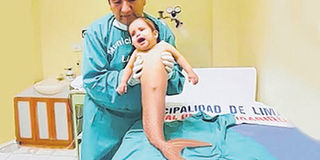Facts and myths behind a mermaid baby

Shiloh Pepin born with a mermaid syndrome.PHOTO|INTERNET
What you need to know:
- I was aware, however, thanks to Edith Hamilton‘s “Mythology, timeless tales of Gods and Heroes”, that mermaids were mythological aquatic creatures with the upper body of a woman and the tail of a fish.
- And that they have been associated with perilous events such as shipwrecks and drownings though sometimes they are adept of tender feelings like falling in love with humans.
Even at the end of five intensive years of training at the medical college, I had never heard of a diagnosis called ‘mermaid syndrome’, a condition also commonly known as sirenomelia.
I was aware, however, thanks to Edith Hamilton‘s “Mythology, timeless tales of Gods and Heroes”, that mermaids were mythological aquatic creatures with the upper body of a woman and the tail of a fish.
And that they have been associated with perilous events such as shipwrecks and drownings though sometimes they are adept of tender feelings like falling in love with humans.
‘…they were marvelous singers whose voices would make a man forget all else, and at last their song would steal his life away,’ so written by Ms Edith as she recounted the adventures of Odysseus after the Trojan War.
In Kiswahili folktales they are usually ascribed as ‘Samaki Mtu’ or simply ‘Nguva’.
In fact, the first time I had come into contact with the diagnosis was about three years ago, in an endeavour to prove wrong my fiancé on the authenticity of a story she had just told me that day.
“There are no any lifetime recorded accounts of a real mermaid,” I had told her as I lay on the bed reading my novel knowing for certain I was right.
“You are always caviling,” she had said irately, “they have found one at the shores of the beach in Dar,” she reiterated for the third time that afternoon.
I knew it was a hoax but I had to prove it to her if by any chance she was going to agree. So we opened her laptop connected an Airtel modem and searched for any recorded account of a mermaid.
What we found made us forget about the duel; eventually, it never mattered who was right or wrong, for we ended up watching a forty-five minutes YouTube video titled; Extraordinary People-The Little Mermaid, Shiloh Pepin.
When she was born seventeen years ago doctors never thought Shiloh could live long enough to speak a word.
“She was missing a whole series of organs including her uterus and her bladder, and her large intestine; she had no vaginal vault or rectum, and no way for urine to get out of her body,” said Dr. Matthew Hand, a kidney specialist at the Barbara Bush Children’s Hospital at Maine Medical Center, who had been treating Shiloh during her life stint.
Having had her first kidney transplant at age two, more than 150 surgeries and years of kidney dialysis, Shiloh had spent her life under the care of doctors.
Luckily enough, she had lived beyond the odds to reach her tenth birthday. She finally rested her poor soul on 23rd of September 2009 at Maine Medical Center due to pneumonia.
At the time of her death she was one of the only three people born with mermaid syndrome that are known to have survived longer.
Mermaid syndrome is a rare congenital deformity in which legs are fused together making the lower part of the body have a mermaid tail appearance.
The condition occurs in 1 out of 100,000 live births at a 3:1 male to female ratio. More than half of sirenomelia cases result into still birth.
Survivors, however, have high mortality rate in neonatorum due to severe malformations that include multi-systems with deaths, usually attributable to failure of kidney development.
Poor or defective development of lower spine with fusion of lower extremities into a single limb or appearance of fixed limbs side by side are common seen in mermaid syndrome.
The condition has been noted to be more common among identical twins, 100 times more common than in singleton or fraternal twins’ births with up to 22 per cent of the fetuses known to have been conceived by a diabetic mother.
The exact cause of the condition is still nebulous. However, scholars have demonstrated that vascular deformities including the aberrant steal vessel, abnormally small abdominal aorta and a two vessel umbilical cord may contribute to the malformations.
Causing vascular steal phenomenon, these aberrations cause severe ischaemia of the caudal portion of the fetus causing a dreadful hypoperfusion leading to the syndrome.
Initial treatment of such patients includes supportive care and diverting colostomy with future emphasis on multidisciplinary surgical approaches.
Though it turned out, as I alleged, that there was no recorded account of real life mermaids, I learnt a thing or two that day.
Firstly, a medical condition I had never come across; and secondly, I believe, a source of myth on “Samaki-Mtu”.
Nonetheless, she never agreed with the search engine results, somehow she still believes we didn’t use the right phrases during our searching; she is still looking for the evidence to refute my convictions to this date.
Dr Lopa is a Medical Doctor at Rabininsia Memorial Hospital in Dar es Salaam.




